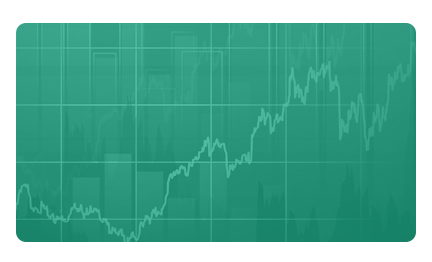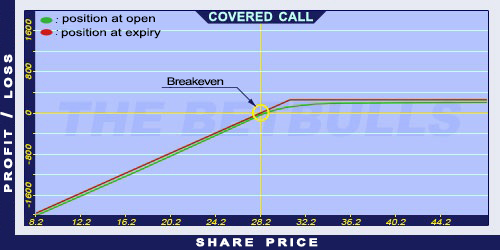Description and use
If an option writer owns the underlying security when the option is sold, the position is called a Covered Call. If the writer does not own the papers, it is called a Naked Call. A Covered Call position is the purchase of the share and the agreement to sell the share if the option is exercised. The position is covered, because the possible delivery of the share is covered by the share already held in the portfolio. Writing an option without a share purchase is called a naked option writing. If the writer decides after how large increase in the share price should the position be closed, then the Short Call option should be sold with that strike price. Then the investor will not be waiting for a higher price to sell and he will keep the premium. The covered obligation to sell is a popular investment strategy. The obligation to sell grants that the share sale will happen the planned way with the planned price. At expiry, the value of a covered obligation to sell equals to the share price plus the Short Call’s (negative) value. The obligation to sell means that the prespecified strike price for the underlying will be exchanged to the Call’s premium when the option is exercised. At expiry, that’s the maximum value of the position. Thus, the option seller’s income is going to be the premium. Sometimes the investor does not want to keep a share for too long but does not want to sell when the difference between the purchase price and the prompt price is already at the same level as when he purchased the shares. The Covered Call strategy is perfect to solve this issue. The direction of the market is mixed, neutral/increasing. The investor expects constant increase on the market. With the increasing prices, the option can be exercised and the profit can be realised. When the prices fall, the sold option expires without being exercised and the premium can be kept. The strategy is a net debit investment. Usually the trading takes place on a monthly basis. The maximum profit is limited from above if the share price equals the strike price at expiration. Therefore, a Covered Call position is the purchase of the share and the agreement to sell the share if the option is exercised.
- Type: Neutral, Bullish
- Transaction type: Debit
- Maximum profit: Limited
- Maximum loss: Unlimited
- Strategy: Income strategy
Opening the position
- Buy shares.
- Sell an OTM Call option with a strike price above the market price.
Steps
Entry:
- Some prefer trading shares between $10.00 and $50.00. They think buying shares above $50.00 would be too expensive.
- Make sure the trend is ascending or stagnating at a certain level.
Exit:
- If the shares close above the strike price at expiry, then the option will be exercised. Shares are delivered at strike price. The profit will be the premium received plus the price increase.
- If the share price is below the strike price but above the Stop Loss at expiration, then the Short Call option should be left to expire worthless and the received premium should be kept. Then another Call option can be sold the next month.
- If the share price is below the Stop Loss at expiration then either the shares should be sold or the trader should start trading in opposite position.
Basic characteristics
Maximum loss: Share price - premium.
Maximum profit: (Strike price - share price) + premium.
Time decay: Time decay has a positive effect on the value. If shares do not reach the strike price, the investor can keep the whole premium and decrease his costs.
Breakeven point: Share price - premium.
Advantages and disadvantages
Advantages:
- It generates monthly profit.
- The risk is lower than owning the shares.
- The investor can profit from share prices moving within given limits as well.
Disadvantages:
- The strategy is said to be expensive because it involves high paying in cash.
- The increase is limited if the share prices increase.
- The decrease is unlimited if the share prices decrease.
Closing the position
Closing the position:
- When the share price is above strike price, the option will be exercised and it will generate profit.
- When the share price is below strike price, the position’s entry fees can be decreased.
- When the share prices fall, the closing of the position depends on whether the investor can sell naked options. If the answer is yes, the investor is exposed to possible unlimited losses. If the answer is no, buy back the option and sell the shares. This is the safest way to close a lossmaking position.
Mitigation of losses:
- Either sell the shares or sell the shares and buy back the Short Call.
- The investor can also buy a Put option which covers the risks. Despite the decreased return, the maximum risk will also decrease.
Example
ABCD is traded for $28.20 on 25. 02. 2017. The investor purchases a share for $28.20. Then, sells a Short Call option which has a strike price of $30.00, expires in March 2017. and costs $0.90 (premium).
Price of the underlying (share price): S= $28.20
Premium (Call): C= $0.90
Strike price: K= $30.00
Debit: D
Maximum loss: R
Maximum profit: Pr
Breakeven point: BEP
Debit: D = S - C
Maximum loss (risk): R = K - C
Maximum profit: Pr = C + K - S
Breakeven point: BEP = S - C
D= $27.30
R = $27.30
Pr = $2.70
BEP = $27.30














